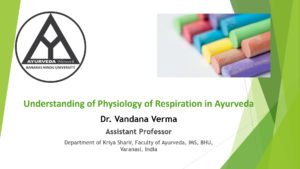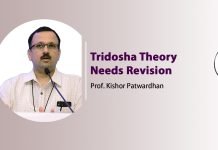Understanding of Physiology of Respiration in Ayurveda
Dr. Vandana Verma, Assistant Professor, Department of Kriya Sharir, Faculty of Ayurveda, IMS, BHU, Varanasi, India
Respiration
Respiration is the process of obtaining oxygen from environment to inside body, its transport up to the tissues and utilisation of oxygen by the cells within tissues to produce energy. The oxygen is obtained from environment to inside of the body by the act of breathing which is also called as external respiration. In Ayurveda the act of breathing i.e. inspiration (Nihshwas) and expiration (ucchswas) has been considered as a vital sign of life and characteristic of Atma. The act of breathing is the physiological function of Prana vata and Udana vata and it is related to Pranavaha srotas. The Pranavaha srotas is a channel or path through which the external air (prana vayu) enters into the body to sustain life.
Pranavaha srotas is understood as respiratory system in context to Sthula srotas , since it take in the Prana vayu (air) as nutrient from external atmosphere through respiratory tract and its main functional contribution in body is to provide oxygen.
Sharandhar has described both external respiration i.e. the mechanism of ventilation, transport of gases and internal respiration i.e. utilisation of oxygen by the cells to produce energy.
Respiration is a biochemical process in which cell of an organism gets energy at cellular level by combing oxygen. There are various references in Ayurveda text under the description of Vata dosha, patho-physiology of Pranavaha srotas, Kostanga , Dhamani , Marma, etc. which suggest the description clinical physiology of Respiration by Ayurveda scholars.
Functional Anatomy of Respiratory tract
Upper respiratory tract extends from nose to pharynx and include the following:
Mouth cavity (mukhavivara) , Nose (nasika), Throat (kantha), Pharynx (grasanika)
Larynx (swaryantra).
Lower respiratory tract extends from pharynx to lungs and includes: Trachea (klomanadi) Bronchi (apasthambh) Lungs (phupphus), Anilayana ( bronchial tree branching as well as alveoli)
Phuphusa (Lung) is the major organ of respiration and Sharangdhar has mentioned that it is situated on left side of heart and called it as Udanavayuadhar. Udana vayu refers to expiration or expired air, since the lungs do not get completely deflated during expiration and few amount of air is always retained in the lungs called as residual air, so it is called as Udanavayuaadhar.
Shrikanta dutta has considered lungs as Raktashya means reservoir of blood. It is very scientific observation since lungs are highly vascular structure and can accommodate 900 ml of blood.
Shshruta has mentioned the word Anilayan for air pathway under the description of Swaraghan a type of Kantagat roga caused by Vata and Kapha. The characteristics of this disorder are seeing darkness before eye, dry throat, breathlessness with wide open mouth, air pathway are obstructed due to Kapha dosha. This description of Anilayaneshuvayubhageshu could be understood as whole shwasmarga i.e. from tracheas to alveoli.
All these references suggest about the anatomical structure of respiratory pathway but there is no reference to suggest the direct functional relation of lungs with the respiration.
उभयत्रोरसो नाड्यौ वातवहे अपस्तम्भौ नाम,(S.sha.6/25)
शोणितफेनप्रभवः फुप्फुसः (S.Sha.4/25) फुप्फुसो हृदयनाडिकालग्नः स्वनामख्यातः (निबन्धसङ्ग्रह व्याख्या (डल्हण कृत)) (Sha.Pu.5/43)
फुप्फुस इति हृदयस्य वामपार्श्वे रक्ताधारः ‘फुप्फुस’ इति ख्यातः|( Commentary by Shrikantdutta on M.Ni. 43/5)
योऽतिप्रताम्यन् श्वसिति प्रसक्तं भिन्नस्वरः शुष्कविमुक्तकण्ठः |
कफोपदिग्धेष्वनिलायनेषु ज्ञेयः स रोगः श्वसनात् स्वरघ्नः ||(S.Ni.16/61) श्वसिति निःश्वसितीत्यर्थः| प्रसक्तं निरन्तरम्| कफोपदिग्धेषु श्लेष्मरुद्धेषु| अनिलायनेषु वायुमार्गेषु| श्वसनात् वातात्| निबन्धसङ्ग्रह व्याख्या (डल्हण कृत)
Shvashan Prakriya :
Sharngadhara has described many important steps of respiratory system physiology, systematically which are as follows:
- Sharngadhara has described that heart is the seat of consciousness and Oja. There are arteries and veins connected with Nabhi ( Umbilicus) which spread all over the body and constantly supply the air (oxygen ) to the tissues for their nourishment (Sha. Pu. 5/47). This refers to transport of gases and utilization of oxygen by the tissues.
Although the major arteries and veins are connected to heart but Sharandhar has mentioned their connection with the Umbilicus this might be possible that he has taken this connection on the basis of fetal circulation as the fetus gets oxygen from mother through the vessels which are connected with umbilicus .
- The Pranavayu which is located in nabhi comes out of throat after touching the Hritakamalantar(heart- lung) to take the Vishnupadamrita(oxygen) from the external environment , after taking Amberpiyush (oxygen) again it comes inside the body with speed (Sha. Pu. 5/48).
- The inhaled air provides nutrition to all body tissues, augments the Jatharagni (power of digestion and metabolism), and the combination of Vayu(air) and body is essential for Ayu(life) (Sha. Pu. 5/49).
This explanation refers to description of internal respiration i.e. utilization of oxygen by cells and release of energy to perform various cellular functions. This refers to the expiratory and inspiratory process i.e. the mechanism of ventilation and gaseous exchange at lung. (Sha.pu.5/48-49)
The above description by Sharngadhara gived the account of important steps of respiratory system physiology which are as follows: External respiration, Internal respiration
The Respiration includes four major steps
- Ventilation
- Pulmonary diffusion
- Transport of gases
- Tissue respiration
Ventilatory Mechanism-(external respiration)
The word nabhi (umbilical region) in relation to ventilatory mechanism could be understood as the participation of diaphragm and abdominal muscles in the process of ventilation.The direction of expiration from abdomen is in the upward direction, through chest and throat region.
Ventilatory Mechanism-(external respiration)
Nabhisthapranapavanh could be understood for supply of nutrients and oxygen from maternal circulation to foetus through umbilical cord in intrauterine life.
Inspiration –
Prana vayu situated in murdha (head, respiratory centres’) gives stimulation to all the muscles of respiration, for expansion. It also stimulates diaphragm and abdominal muscles. Due to its activity the chest cavity broadens and inspiration occurs (A.H.Su.12/5).
-प्राणोऽत्र मूर्धगः| उरःकण्ठचरो बुद्धिहृदयेन्द्रियचित्तधृक्||४|| ष्ठीवनक्षवथूद्गारनिःश्वासान्नप्रवेशकृत्|(A.H.Su.12/5)
Expiration-
Udana vayu is responsible for the process of expiration (S.Ni. 1/14)
उदानो नाम यस्तूर्ध्वमुपैति पवनोत्तमः | तेन भाषितगीतादिविशेषोऽभिप्रवर्तते | (S.Ni.1/14)
भाषितगीतादिरिति आदिशब्दादुच्छ्वासादि (Dalhan commentary on S.Ni.1/14)
Regulation of ventilation–
The activity of Prana and Udana vata refers to nervous regulation of ventilation. The activity of Inspiration is regulated by Prana vata where as expiration is by Udana vata. Main dwelling Site of Prana vata is Murdha (head). The Inspiratory and expiratory group of neurons are situated in Medulla and Pons. यो वायुर्वक्त्रसञ्चारी स प्राणो नाम देहधृक् |(S.Ni.1/13)प्राणोऽत्र मूर्धगः| उरःकण्ठचरो बुद्धिहृदयेन्द्रियचित्तधृक् | ष्ठीवनक्षवथूद्गारनिःश्वासान्नप्रवेशकृत्|(A.Hri Su.12 /5)
Gaseous exchange- ‘Spristvahritakamalantaram’ word indicates the gaseous exchange at the alveoli, after that the impure air comes outside through the kanta (throat, nasophrynx). Here word ‘Hritakamalantar’ could be synonymous for lungs as amberpiyush word is used for oxygen.
Transportation of gases–
In Pranavaha srotas , external prana dravya ( vayu/oxygen) is taken into blood by the lungs and then it is transported with Rasa-Rakta throughout the body via heart by the action of Vyana vata. Sharangdhar has described about the Dhamani (artery) and Shira (vein) which are connected with Nabhi (umbilicus) and spread all over the body and supply air to all the tissues (Sha.Pu.5/47) Dhamani (artery) carry Rasa dhatu all over the body and fill it with air (Sha.Pu.5/39). All these description may be understood as transportation of gases through circulation of blood and supply of oxygen to tissues.
Sharngadhara has mentioned the role of Vayu (air/oxygen) in dhatu-poshana or tissue nourishment and this explanation refers to cellular metabolism in the presence of oxygen.
(Sha.pu.5/39)
(Sha.pu.5/47).
युनक्ति प्राणिनं प्राणः शोणितं ह्यनुवर्तते||(C.Su. 24/4).
शjhjizk.k;ksjso la;ksxknk;q#Pprs (Sha.pu.5/54)
Kshut(sneezing reflex)
Kshut (sneezing) is the sound produced in the nose by upward movement of prana and udana vayu and kapha in the head. This description could be understood as sneezing reflex for clearance of upper respiratory tract.
( Sha.Pu. 6/27)
Measures to establish breathing ( Pranapratyagaman):
Prana(breath), Pratyagaman (establishment)
In Sharirsthan Charak has given various measures for establishment of respiration in just new born baby like striking of stones near the ears of child, sprinkling of hot and cold water on face. If baby does not gain vitality then the baby should be fanned with a fan prepared with straps of bamboo (C. Sha. 8/42). All these measures indicate the description of resuscitation and artificial respiration.
तस्यास्तु खल्वपरायाः प्रपतनार्थे कर्मणि क्रियमाणे जातमात्रस्यैव कुमारस्य कार्याण्येतानि कर्माणि भवन्ति; तद्यथा- अश्मनोः सङ्घट्टनं कर्णयोर्मूले, शीतोदकेनोष्णोदकेन वा मुखपरिषेकः , तथा स क्लेशविहतान् प्राणान् पुनर्लभेत|
कृष्णकपालिकाशूर्पेण चैनमभिनिष्पुणीयुर्यद्यचेष्टः स्याद् यावत् प्राणानां प्रत्यागमनम् (C. Sha. 8/42).
All the textual references i.e. Samhita chapter number and verse number have been mentioned in the text.
Abbreviations: C.- Charak, S.- Shusruta, A.- Astanga, Sang. – Samgrah, Hri. – Hridyam, Su. Sutrasthan, Ci. Chikitsa sthan, Sha. Sharir shtan, Siddhi. – Siddhishtan, In. – Indryia shtan, Vi. – Viman sthan
Assessment: Multiple choice questions
Q.1. Which dosha regulates the Breathing mechanism.
- Prana Vata
- Udana Vata
- Both 1&2
- None
Q.2. Which dosha regulates the act of inspiration.
- Prana Vata
- Udana Vata
- Saman Vata
- Vyana Vata
Q.3. Which is responsible for regulation of act of expiration:
- Vyana Vata
- Saman Vata
- Udana Vata
- None
Q.4. Which statement is not true about the Phuphusa.
- It is called as Udana vayuaadhar.
- It is considered as Raktashaya
- It is a Koshtang
- None
Q.5. Which is responsible for sneezing:
- Prana vata
- Udana Vata
- Kapha Dosha
- All of the above
Q.6. What is the measure for establishment of breath in new born baby:
- Sprinkling cold water on face of baby
- striking of stones near the ears of child
- Both
- None
Q.7. What is the effect of inhaled air (prana vayu) in the body:
- Augment the Agni
- Help in nourishment of tissues
- Both 1&2
- None
Q.8. Which statement is true about Pranavaha Srotas :
- It is channel which carry Prana vata
- It is a sthoola Srotas
- Both
- None
Q.9 Which statement is true about the word Pranaapanau:
- Prana refer to Inspiration
- Apana refers to expiration
- It is related to Atma
- All of the above
Q.10 The word AmberPiyush refers to:
- Oxygen
- Carbon dioxide
- Both
- None
Answer sheet for MCQ
| Question no | Answer | Question no | Answer |
| 1 | 3 | 6 | 3 |
| 2 | 1 | 7 | 3 |
| 3 | 1 | 8 | 3 |
| 4 | 4 | 9 | 4 |
| 5 | 4 | 10 | 1 |
xxxxxxxxxxxxxxxxxxxxxxxxxxxxxxxxxxx






Hello,
very nice video of Dr Vandana Verna. Thank you for your contribution to the teaching of Ayurveda.
Regards.
Namaste.